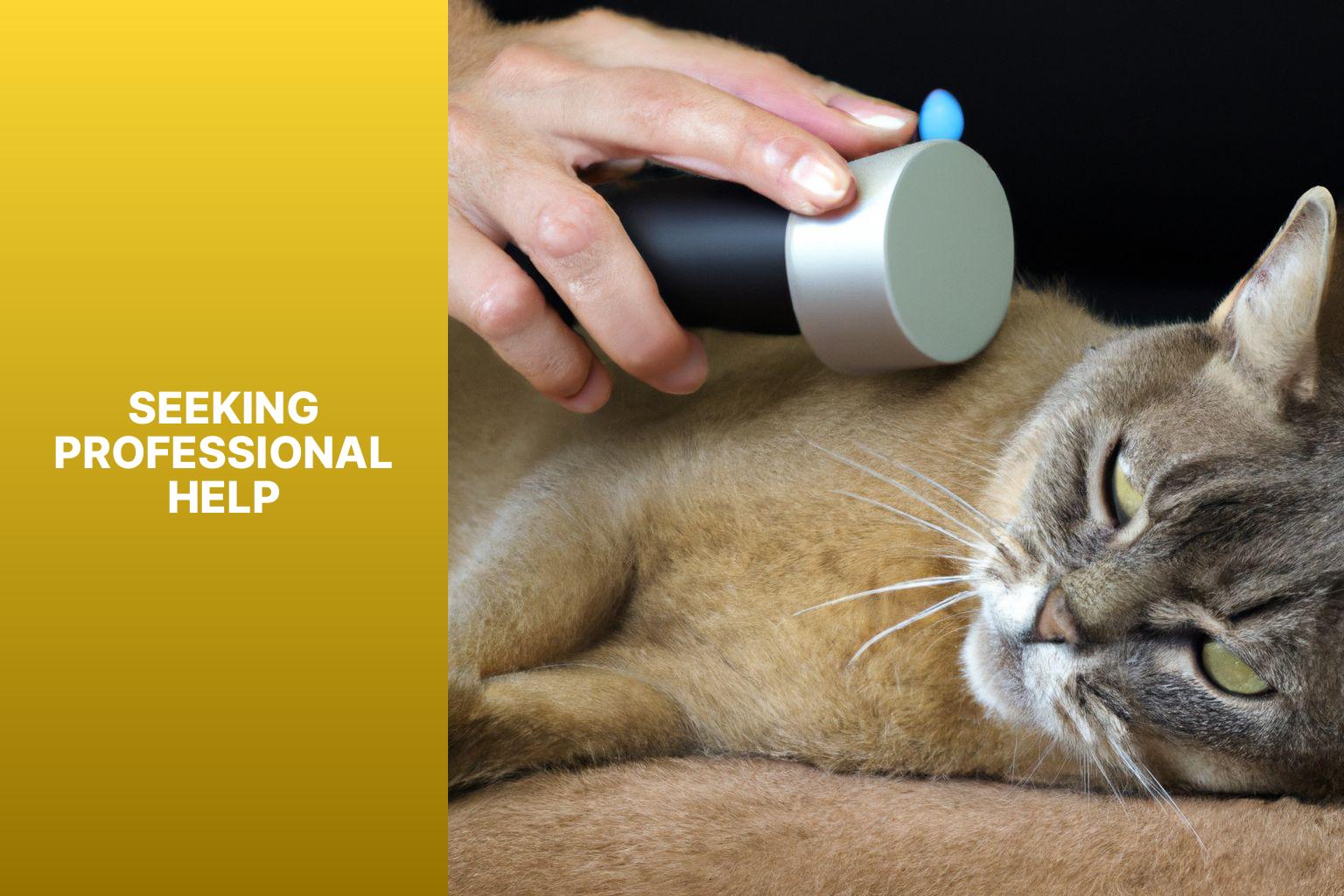Shaving a cat is a topic that may raise some questions and concerns among pet owners. While it may not be necessary for all cats, there are certain situations where shaving can be beneficial. Understanding the purpose and benefits of cat shaving can help you make an informed decision for your furry friend’s well-being.
The purpose of cat shaving can vary depending on the specific circumstances. Reducing fur matting and tangles is one common reason for shaving, as it can help prevent discomfort and skin issues that can arise from neglected fur. Shaving can also assist in managing seasonal shedding, making it easier to control and clean up excessive fur. In warmer climates, shaving can help prevent overheating and provide relief to your cat during hot seasons.
Knowing when to consider shaving your cat is essential. Factors such as the breed and coat type of your cat play a role in determining the necessity of shaving. Some long-haired breeds are more prone to matting and may benefit from regular shaving. Certain health risks and conditions, such as excessive hair swallowing or skin allergies, may warrant a shave to alleviate symptoms.
Before proceeding with shaving, it’s important to prepare your cat for the process. Grooming and brushing your cat regularly can help minimize tangles and make the shaving experience more comfortable. Introducing your cat to the clippers and tools gradually can help them become familiar and decrease anxiety or fear associated with the grooming process.
When it comes to actually shaving your cat, using the right tools and equipment is crucial. Choosing clippers specifically designed for pets and using proper techniques can help ensure a safe and effective shave. Creating a calm and comfortable environment for your cat during the process is also essential to reduce stress and anxiety.
After shaving, caring for your cat’s skin is important. Bathing and cleaning your cat helps remove any loose hair and debris. Moisturizing the skin can help prevent dryness or itchiness, especially if your cat has sensitive skin.
If you feel unsure or uncomfortable about shaving your cat yourself, seeking professional help can be a viable option. Professional groomers can provide expert care and ensure a safe and stress-free grooming experience for your furry friend.
By considering these factors and following proper guidelines, you can make the best decision regarding whether or not to shave your cat and ensure their well-being and comfort.
Key takeaway:
- Shaving a cat can help reduce fur matting and tangles, promoting a healthier coat.
- Shaving a cat is beneficial in managing seasonal shedding and preventing overheating in warmer climates.
- Before shaving a cat, consider factors such as the breed and coat type, as well as potential health risks.
- Proper preparation, including grooming and getting the cat familiar with clippers, is essential for a safe shave.
- Choose the right tools and create a calm environment when shaving a cat to ensure the process is stress-free.
- After shaving, provide post-shave care through bathing, cleaning, moisturizing, and protecting the cat’s skin.
- In cases where you lack experience or confidence, it is advisable to seek professional help for cat shaving.
Is Shaving a Cat Necessary?
Is shaving a cat necessary? Let’s dive into the purpose of cat shaving and uncover the reasons behind this controversial practice. Discover the fascinating insights and considerations that surround the topic, shedding light on the potential benefits and drawbacks. Buckle up, as we explore the intricacies of cat shaving and unravel the mysteries behind this contentious grooming habit.
Understanding the Purpose of Cat Shaving
Understanding the purpose of cat shaving is crucial for pet owners. Shaving a cat has numerous benefits for both the cat and the owner.
Cat shaving plays a significant role in reducing fur matting and tangles. Cats with long or thick fur are prone to developing uncomfortable and painful mats and tangles. Shaving helps prevent these issues and maintains the cat’s coat in good condition.
Shaving contributes to managing seasonal shedding. Cats regularly shed fur, and excessive shedding can lead to hairballs and allergens in the home. Shaving reduces shedding, making it easier for owners to manage and keep their homes clean.
Shaving a cat is essential for preventing overheating, especially in warmer climates. Cats with dense fur struggle to regulate their body temperature in hot weather. Shaving helps keep cats cool and comfortable.
When deciding whether to shave your cat, consider these factors. Each cat’s breed and coat type may influence the need for shaving. Take into account any potential health risks or conditions that could be affected by shaving.
Before attempting to shave your cat, it is crucial to properly groom and brush them to minimize discomfort. Familiarize your cat with clippers and grooming tools to create a relaxed environment.
During the shaving process, be sure to choose the right tools and equipment for a safe and efficient procedure. Create a calm and comfortable environment for your cat and utilize proper techniques to avoid harm.
After shaving, provide post-shave care by bathing and cleaning your cat’s skin. Moisturize and protect the skin to maintain its health and condition.
If you feel uncertain or uncomfortable with shaving your cat yourself, it is recommended to seek professional help to ensure the safety and well-being of your furry friend. Understanding the purpose of cat shaving will assist you in making informed decisions about your cat’s grooming routine.
Benefits of Shaving a Cat
Shaving a cat? You might be surprised to learn that there are actually benefits to this unique grooming practice. In this section, we’ll uncover the advantages of shaving a cat, including reducing fur matting and tangles, managing seasonal shedding, and preventing overheating in warmer climates. So, grab your clippers and get ready to explore the upsides of giving your feline friend a stylish and practical trim.
Reducing Fur Matting and Tangles
Reducing fur matting and tangles is a key benefit of shaving cats. Shaving helps eliminate knots and tangles, preventing them from becoming larger and more difficult to remove. This practice also reduces the risk of matting, which in turn can cause pain and skin infections. Shaving enables improved access to the skin, making it easier to maintain the cleanliness and overall health of the cat’s coat. Regular tangle-free grooming enhances the appearance of your cat’s fur, keeping it sleek and well-maintained.
Fact: Cats engage in allogrooming, a grooming behavior where they help each other remove tangles and matting.
Managing Seasonal Shedding
Managing seasonal shedding is important for cat grooming to maintain their coat and prevent excess fur in the house. Here are some tips for effective shedding management:
- Brush your cat’s coat regularly to remove loose fur and prevent matting. This reduces shedding and keeps their coat neat.
- Invest in a high-quality shedding tool designed for cats to effectively remove loose hair from the undercoat.
- Provide a balanced diet rich in essential nutrients like omega-3 fatty acids to promote healthy skin and coat, reducing excessive shedding.
- Increase grooming during shedding season to control your cat’s coat.
- Create a calm and stress-free environment for your cat to minimize shedding.
By following these tips, you can effectively manage your cat’s seasonal shedding, maintaining a healthy and shiny coat. Remember, regular grooming and a balanced diet are key to reducing shedding and keeping your feline friend healthy.
Preventing Overheating in Warmer Climates
When it comes to preventing overheating in warmer climates, consider the following:
– Proper grooming: Regular grooming helps remove excess hair and promote air circulation, keeping cats cool.
– Provide shade and ventilation: Give cats access to shaded areas and ensure proper ventilation in their living space for fresh air circulation.
– Hydration: Keep cats well-hydrated by providing fresh, clean water at all times. Consider using water fountains or adding ice cubes to their bowl during hot weather.
– Avoid hot surfaces: Keep cats away from hot surfaces like pavement or metal objects that can burn their paws.
– Limit strenuous activities: During hot weather, avoid playing or exercising cats during the hottest times of the day to prevent overheating.
– Cooling techniques: Place a damp towel or cooling mat for cats to lie on. Use a fan or air-conditioning to provide additional cooling.
– Monitor behavior: Watch for signs of overheating such as excessive panting, lethargy, or seeking cool surfaces. Take immediate steps to cool them down and consult a veterinarian if necessary.
When Should You Consider Shaving Your Cat?
When Should You Consider Shaving Your Cat?
Shaving your cat can be necessary in certain situations. Consider the comfort level of your cat. If your cat has long, thick fur and is struggling with heat, shaving can provide relief. Shaving may also be necessary to prevent discomfort or skin issues if your cat has mats or tangles that cannot be effectively managed with brushing.
Another reason to consider shaving is if your cat has a medical condition that requires close monitoring. Shaving makes it easier to spot changes or abnormalities on the skin and allows for better treatment or prevention of potential issues.
Not all cats need to be shaved. Some cats naturally have short or low-shedding fur, so shaving may not be necessary or beneficial for them.
If you decide to shave your cat, consult a professional groomer or your veterinarian. They can provide guidance on the best approach and ensure the safety and well-being of your cat.
Always prioritize your cat’s comfort and consult professionals when considering shaving.
Things to Consider Before Shaving Your Cat
Deciding to give your furry feline companion a new look by shaving them can be a big decision. But before you break out the clippers, there are a few important factors to keep in mind. In this section, we’ll dive into the breed and coat type of your cat, as well as potential health risks and conditions associated with shaving. So, before you embark on this grooming adventure, let’s explore the vital considerations that will ensure a safe and happy experience for your cat.
The Breed and Coat Type of Your Cat
The Breed and Coat Type of Your Cat is important when deciding to shave. Different breeds and coat types have different grooming and shaving needs.
Here is a table that provides information about the Breed and Coat Type of Your Cat:
| Breed | Coat Type |
|---|---|
| Persian | Long and dense |
| Siamese | Short and fine |
| Maine Coon | Semi-long and thick |
| Sphynx | No fur |
| Ragdoll | Semi-long and silky |
Understanding your cat’s breed and coat type is important. It determines if shaving is necessary and how it should be done. Cats with long, dense coats like Persians may benefit from shaving to prevent matting and tangles. On the other hand, cats with short and fine coats like Siamese may not need shaving as their fur sheds easily.
Always consult a professional groomer or veterinarian for the best approach for your cat’s breed and coat type. They can provide guidance on whether shaving is necessary and how to properly care for your cat’s fur.
Potential Health Risks and Conditions
When it comes to cat shaving, it’s important to be aware of the risks and conditions involved. Shaving a cat can cause skin irritation, sunburn, hypothermia, emotional stress, insect bites, and allergies. Skin irritation can occur if clippers are unsanitized or if the process is too rough, resulting in redness, inflammation, and discomfort. Without fur, cats are vulnerable to sunburn, which can lead to pain, peeling skin, and even skin cancer. Shaving can disrupt a cat’s natural insulation, increasing the risk of hypothermia in colder climates. Cats also experience emotional stress from the change in routine and appearance, potentially leading to behavioral issues or anxiety. Shaved cats are more exposed to insect bites and allergies from grooming products or fabrics, causing irritation or allergic reactions.
Before deciding to shave your cat, consult with a veterinarian who can provide guidance based on your cat’s needs and ensure their well-being. I once knew someone who shaved their long-haired cat during the summer, resulting in severe sunburn and the need for veterinary treatment. This incident emphasized the importance of considering potential risks and seeking professional advice when grooming cats.
Preparing Your Cat for a Shave
cat ready. We’ll explore the importance of grooming and brushing, as well as how to familiarize your cat with clippers and tools. Get ready to transform your cat’s mane with expert techniques and helpful tips.
Grooming and Brushing Your Cat
When grooming and brushing your cat, it is important to follow these steps for a healthy and tangle-free coat. Start by choosing a suitable grooming brush or comb based on your cat’s coat type. If your cat has long hair, it is best to use a wide-toothed comb or slicker brush. For short-haired cats, a rubber curry brush or grooming glove works well.
Introduce the grooming tools to your cat by allowing them to sniff and investigate before using them. This will help them become familiar and comfortable with the tools.
When brushing your cat, make sure to brush their back and sides in the direction of hair growth using light strokes. Be cautious around sensitive areas like the belly and tail to avoid causing any discomfort.
If you come across any mats or tangles, it is important to carefully separate them using your fingers or a mat splitter. Avoid pulling or tugging on the hair as this can cause pain and potential injury.
If your cat becomes agitated or anxious during the grooming process, take breaks. You can offer treats, praise, or play breaks to keep them calm and engaged.
It is important to regularly check your cat’s ears, paws, and tail for debris or knots. Clean their ears using a damp cloth and trim any excessive fur around the paws to prevent matting.
After grooming, make sure to reward your cat with treats, playtime, or cuddles. This will help create a positive association with the grooming experience.
Remember, regular grooming and brushing not only maintain your cat’s coat health, but also encourage bonding and allow you to monitor their overall well-being.
Getting Your Cat Familiar with Clippers and Tools
Before attempting to shave your cat, it is important to get them familiar with clippers and tools. Here are steps to help you accomplish this:
- Introduce the clippers and tools to your cat gradually.
- Allow your cat to explore and sniff the tools to become familiar with their scent.
- Hold the clippers near your cat without turning them on to get them used to the sound.
- Give your cat positive reinforcement, such as treats or praise, when they show curiosity or interest in the tools.
- Gently touch your cat’s body with the clippers, without using them.
- Once your cat is comfortable, turn on the clippers and let them run near your cat to familiarize them with the vibrations.
- Gradually move the clippers closer to your cat’s body, always monitoring their reaction.
- If your cat becomes anxious or stressed, take a step back and give them a break before continuing.
Remember, take your time and be patient while getting your cat familiar with clippers and tools. Rushing can cause fear or anxiety. By gradually introducing the tools, you can create a relaxed and positive experience for both you and your cat.
How to Shave Your Cat Safely
In the fascinating world of cat grooming, ensuring your feline friend’s comfort and safety is paramount. This section will guide you through the process of safely shaving your cat, covering essential aspects like selecting the right tools, creating a serene environment, and employing proper techniques. Say goodbye to matted fur and embrace a smoother, happier cat while gaining peace of mind as you embark on this grooming adventure!
Choosing the Right Tools and Equipment
When choosing clippers for grooming cats, it is important to find ones that are specifically designed for this purpose. Look for clippers that are quiet, have adjustable blades, and are easy to maneuver.
Before starting the shaving process, ensure that the blades of your clippers are sharp. This is crucial for achieving a clean and efficient shave. Dull blades can cause discomfort to the cat and result in uneven cutting.
Prior to shaving, use a grooming comb to remove any tangles or mats from the cat’s fur. This will make the shaving process easier and prevent any unnecessary pulling on the fur.
Keep safety scissors on hand to trim hard-to-reach areas, like around the ears or paws, that may be difficult to handle with clippers alone.
For added protection, consider wearing protective gloves while grooming to prevent scratches or bites. This will also help maintain a firm grip on the clippers.
Pro-tip: Before using the clippers, introduce the sound and feel of them to your cat. This will help the cat become more comfortable and minimize any anxiety or fear during grooming.
Creating a Calm and Comfortable Environment
Creating a calm and comfortable environment is imperative when shaving a cat. Cats, being sensitive creatures, can easily get stressed, so it is crucial to establish a tranquil atmosphere for their safety and well-being. To achieve this, it is important to choose a serene and familiar space where your cat feels at ease.
While grooming, it is essential to minimize any distractions or loud noises that may frighten your cat. Incorporating soft lighting and soothing music can contribute to creating a relaxed ambiance. Make sure to keep all the necessary tools and equipment, such as clippers, combs, and scissors, within reach to prevent any sudden movements that could startle your cat.
By creating a calm and comfortable environment, you will be able to lessen your cat’s stress levels, resulting in a smoother and safer shaving process for both you and your cat.
Using Proper Techniques to Shave Your Cat
Incorporating Proper Techniques to Shave Your Cat
1. Start by preparing the clippers: Before you begin, make sure the clippers are clean and in good condition. Check the blades for any signs of damage or dullness.
2. Create a calm environment: Find a quiet area where you and your cat can relax during the shaving process. It’s important to minimize distractions and noises to help your cat feel more at ease.
3. Familiarize your cat with the clippers: Gradually introduce them to the buzzing sound of the clippers. Let your cat sniff and investigate the clippers while they are turned off. Remember to reward positive interactions with treats and praise.
4. Position your cat comfortably: Place your cat on a non-slip surface to prevent slips or falls. Use gentle but firm restraint techniques to keep your cat still and secure during the shaving process.
5. Begin with gentle strokes: Start by removing longer hair in the direction of growth. Apply light pressure to avoid causing any discomfort or skin irritation. If your cat becomes restless or stressed, take breaks as needed.
6. Shave in sections: Divide your cat’s body into different areas and work on one area at a time. Start from the head and move towards the tail. Be cautious when shaving around sensitive areas like the face, ears, and genital area.
7. Take breaks when necessary: Pay careful attention to your cat’s behavior and body language. If you notice any signs of distress or discomfort, stop shaving and allow your cat to relax before you continue. Remember, your cat’s well-being is the top priority.
8. Monitor the temperature: Ensure that the clippers and the surrounding area are not too hot, as this can lead to overheating your cat. Take breaks to cool down and use wet towels to help regulate your cat’s body temperature if necessary.
9. Check for nicks or cuts: After shaving, thoroughly inspect your cat’s skin for any signs of nicks or cuts. If you notice any, gently clean the area with a pet-safe antiseptic solution and apply pet-safe ointment to promote healing.
Remember, it’s always best to consult a professional groomer or veterinarian before attempting to shave your cat, particularly if you are unsure or lack experience. By employing proper techniques and prioritizing your cat’s comfort and safety, you can achieve a successful and stress-free shaving experience.
Post-Shave Care for Your Cat
After giving your furry friend a fresh shave, it’s crucial to provide proper post-shave care. In this section, we’ll take a closer look at how to pamper your cat after a shave, ensuring their comfort and well-being. We’ll cover essential topics such as bathing and cleaning, as well as the importance of moisturizing and protecting their delicate skin. So, let’s dive in and discover the best ways to keep your cat feeling great and looking their best after a shave!
Bathing and Cleaning Your Cat
Bathing and cleaning your cat requires following a proper process to ensure their comfort and safety. Here are the steps:
- Prepare everything you need in advance: cat-friendly shampoo, towels, and a gentle brush.
- Fill a sink or basin with warm water that is comfortable for your cat.
- Gently place your cat in the water, keeping their head above the water level.
- Use a small amount of cat-specific shampoo, lather it into their fur, avoiding the eyes, ears, and mouth.
- Rinse your cat thoroughly with clean water to remove all the shampoo, ensuring no soap residue remains.
- Gently dry your cat with a towel, removing as much moisture as possible.
- If your cat allows it, use a brush to comb their fur and remove tangles or mats.
- Monitor your cat after the bath for signs of stress or skin irritation. Consult a veterinarian if any issues arise.
Regular bathing and cleaning promotes healthy fur and skin while fostering bonding between you and your pet. Always approach the process calmly and patiently, and never force your cat if they are uncomfortable.
Moisturizing and Protecting the Skin
Moisturizing and protecting the skin is essential after shaving your cat for their comfort and well-being.
To hydrate the skin, use a cat-friendly moisturizer and gently apply it to the shaved areas. This will replenish moisture and prevent dryness or flakiness.
In order to protect against sun damage, make sure to apply pet-safe sunscreen to areas exposed to sunlight during warmer months. This will prevent sunburn and potential skin damage.
To prevent skin irritations, it is important to monitor your cat’s skin for signs of irritation or redness after shaving. If any issues arise, consult a veterinarian for appropriate treatment or skincare products.
It is crucial to avoid using harsh chemicals. Choose gentle and natural skincare products that are specifically formulated for cats. This will help prevent further irritation or discomfort.
Regular grooming is key in post-shave care for your cat. Continue to brush their fur regularly as it helps distribute natural oils and prevent matting. This will keep their skin healthy and free from tangles or discomfort.
Proper moisturizing and skin protection are crucial in post-shave care for your cat. By following these guidelines, you can ensure your cat’s skin remains healthy and comfortable after shaving.
Seeking Professional Help
Photo Credits: Www.Catcornerblog.Com by Gabriel Wilson
Seeking professional help is of utmost importance when faced with the challenge of shaving a cat. Professional groomers possess the necessary skills and experience to handle this task meticulously and with great care. They are well-versed in the proper techniques and come equipped with specialized tools like cat-friendly clippers and grooming tables. This ensures that the cat remains calm and comfortable throughout the entire process while achieving the most favorable results.
The significance of seeking professional help cannot be emphasized enough. Attempting to shave a cat without the required expertise can result in unfortunate accidents and injuries for both the person involved and the cat itself. It is always better to rely on professionals who are well-acquainted with handling cats in a grooming environment.
In a real-life incident, a cat owner named Sarah attempted to shave her long-haired feline companion at home. Despite her efforts, she struggled to keep the cat still and accidentally caused a small cut on its skin. Recognizing the need for professional assistance, Sarah reached out to a local groomer who successfully completed the shaving process in a safe manner. This experience taught Sarah the valuable lesson of seeking professional help for delicate and potentially risky grooming tasks such as cat shaving.
Some Facts About How To Shave a Cat:
- ✅ Shaving a cat’s fur can help reduce shedding and hairballs, especially during the summer months. (Source: PetKeen)
- ✅ Some cats may develop severe matting, which may require them to be shaved. (Source: PetKeen)
- ✅ It is recommended to consider taking your cat to a professional groomer due to the sensitivity of their skin, but if that is not an option, you can do it yourself. (Source: PetKeen)
- ✅ The necessary supplies for shaving your cat include clippers, a brush, a way to secure your cat, and rubber gloves to prevent scratching. (Source: PetKeen)
- ✅ Before starting the shaving process, brush your cat’s coat to make sure it is clean and free of knots. (Source: PetKeen)






